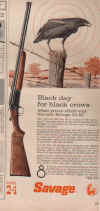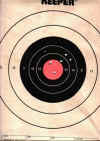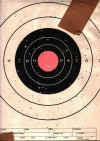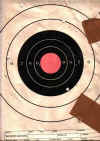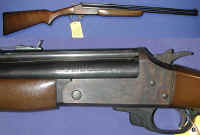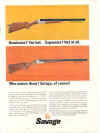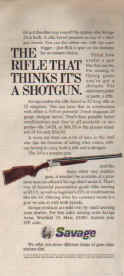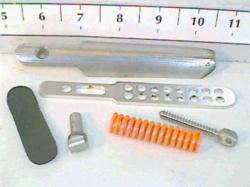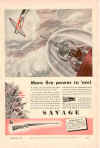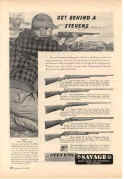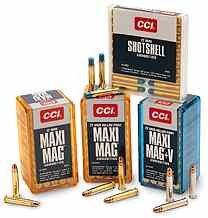|
Combinations in Pairs: Two Savage 24s An AK Church and John Dunn joint effort NOTE: Authors Church and Dunn regret that t hey are unqualified to do appraisal, and cannot establish a value on your gun. Click any thumbnail-photo for a larger image. (Free permission to quote Church's articles is granted, as long as proper attribution is given. We request that if you use our work, you give us credit.) 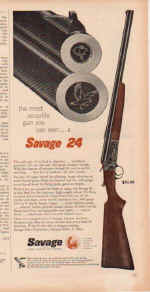 Introduced
immediately prior to the Second World War as the Stevens .22-.410, the
utilitarian combo gun has gone through innumerable variations. Earlier
guns had fully interconnected barrels, top lever opening, a barrel
selector mounted to the receiver side, and was made only in .22 LR and
.410 3 inch. Introduced
immediately prior to the Second World War as the Stevens .22-.410, the
utilitarian combo gun has gone through innumerable variations. Earlier
guns had fully interconnected barrels, top lever opening, a barrel
selector mounted to the receiver side, and was made only in .22 LR and
.410 3 inch.
The problem prone side mount barrel selector has gone away for a much better hammer mounted switch, 20 gauge was added by the mid 1960s, .22 WRFM by the late ’50s, and eventually centerfire varieties arrived. Barrel releases have moved from the top tang to the receiver sidewall in a 1960s economy series, and then to the front of the trigger guard. Still in production in a much evolved form, these newer guns chamber full power rifle rounds and have added 12 gauge to the shotgun column (.410 is gone). They carry the lawsuit resistant manual safety, synthetic stocks, and significant price increases, but is still recognizably descended from the 1939 gun. Visit Savage Arms' web site for details of the modern incarnation. General Information All Savage 24s are break action over-under guns with a manually cocked external hammer, rifle barrel above the shotgun barrel. Savage never developed the taste Colt or Smith & Wesson developed for use of lightweight alloys so these guns tend to be fairly heavy. Extractors rather than ejectors are the usual order. The Lone Gunman Model 24-N AK Church wearing John's Savage Author Dunn acquired a prime specimen of pawnshop Savage. In NRA Very Good condition, his chambers .22LR and 20 gauge 3”. Of apparent 1970s manufacture, his carries a case finished receiver, blued barrels, trigger and guard, and is stocked in pale wood looking for all the world like Finland birch. It also came with an additional die-cast folding buttstock of mysterious origin, unpleasant to shoot with 3 inch magnum. Two views of the folding stock We removed the stock to get some close-up shots of the mechanism itself. Here, you can see the top of it showing the allen-wrench style attaching face. Photos courtesy of Heidi of Michigan The trigger guard is of a form author Church found illustrated in his “SHOOTER’S BIBLE” for approximately 1972-75. Based on this, we are guessing production to date from the early 1970s. Left side, showing tang release and faded case-hardening The Dunn gun early on appeared to exhibit functioning problems with the shotgun barrel, giving a misfire rate with Remington 3/4 oz field loads approximating 50%. The same ammo was tried in AK Church’s 24 and gave the same results. It has functioned reliably with everything else ever fed it. The .22LR barrel never tried to malfunction, even with a promiscuous diet of ammo ranging from Aguila bumblebee ammo to Lapua match. We have failed to have film for any rifle targeting sessions, but accuracy with Remington Target .22LR averages 2"-2.5" at 100 yards, off crude iron sights. Action opened to expose chambers and extractors Some minor issues of age have exhibited themselves on the gun: the mousetrap spring tensioning the forend has grown anemic, and the pin retaining the trigger has loosened enough to allow a good bit of side to side trigger play. The forend spring is a straight parts replacement issue, and the pins have received light and careful restaking. The Dunn gun seems to weigh slightly less than the rated 6.5 pounds, and to handle faster and more precisely because of that. It takes down to a nice manageable package, as shown below. Savage 24-F.G. (taken from the 1974 “SHOOTER’S BIBLE”): Barrels 24 inch, .22LR/20 gauge 3”, length overall 40”. Accuracy results appended below: The .22 long rifle barrel at fifty yards. Pardon the flyer.
Bird shot seemed to pattern satisfactorily. This result was obtained using Winchester AA bird shot, 2 3/4" shells 7/8 oz.
Remington Express 2 3/4" buckshot performed much less satisfactorily at 25 yards. This may or may not be a malfunction of the ammunition; more likely it is due to the way the barrel is choked. Only nine pellets hit the paper (a tenth one caught the extreme right edge) with none of them "in the black"; only four made it into the outermost ring at all. They seemed to want to migrate to the right...was this the ammo's fault, the gun's fault, or the shooter's fault?
THE A K Church 24-S The "Church Gun". Note the nifty custom-made Bill Beumer leather shell holder. Dunn's gun now sports one of these as well; the photos of his specimen were taken when he was still using the temporary nylon variety found at any X-Mart until the superb leather one was complete. Here is a photo of it on John's gun: Please note that the lighter coloration of the loops themselves vs. the overall sleeve is an optical gaff resulting from the lighting conditions when the photo was taken. The shell carrier is all one rich brown leather color. The test gun described herein was found unfired in the box, but with minor handling dings, shelf wear and the instruction manual gone. It is chambered in .22WRM over 20 gauge 3 inch. The Church piece carries a late production polymer trigger guard with barrel release incorporated, non walnut mystery wood with a distinctly purple tinge, and weighs nearly a pound more than the lightning fast Dunn gun. We postulate production as 1980s. The Church gun showed immediate distaste for the same Remington/Walmart field loads Dunn‘s specimen disdained, and indiscriminate acceptance of everything else stuffed in its chambers.
The newer gun weighs noticeably more than the Dunn gun and feels substantially less lively. The Church gun carries a buttstock mount shell carrier for 5 rounds of 20 gauge, which was crafted by Bill Beumer of Baldknobber Holsters. He may be reached @ 417-844-2174. 24 of identical layout to Church's, this shows separated barrels, trigger guard barrel release, and barrel spacer near muzzle. Illustration is .22LR/.410. Handling properties Both guns offer adequate to good accuracy. Down sides include marginal trigger pulls and iron sights, and lackadaisical extractors. Weight (at least for non-folding butts) is sufficient to keep recoil of normal 20 gauge field loads quite tolerable. The lighter ’70s era gun gets more bumptuous with Fiocchi 1 1/8 ounce 3 magnums, but it’s tolerable in small doses. Operation,
takedown, and reassembly: The Savage 24 is a typical break-open shotgun. To load and fire, push the opening lever. The opening lever may be of one of 4 types. (1) The single directional tang mounted push lever, as issued with the John Dunn piece; (2) The bi-directional tang lever used on the DT model described later; (3) The front of trigger guard button type release used on the A K Church gun; (4) The side-of-receiver mounted lever used on some '60s to early '70s economy models. After pushing the opening lever, the barrel will swing open to expose the over/under chambers. In the 24 the sequence will always be rifle on top, shotgun on bottom. Load barrels with appropriate ammo, and recall the uncommon 24C "Camper's Companion" model has a 2 3/4", not 3" chamber. Close the barrels. Select the rifle or shotgun barrel using either the hammer mounted selector or the receiver mounted sliding button on older models. The rifle barrel will be the rearward detent on the hammer-mounted model, or on the upper detent on the seldom still-functional receiver mounted. Cock the hammer, point it at the intended target, and pull the trigger. It should go boom. Push the opening lever again, and barrel weight should open them. Empties will be pushed back slightly by extractors for manual removal. This goes better if your fingers aren't numb from cold, or encased in gloves to prevent them from being numb with cold. To disassemble the hopefully unloaded gun pull down on the tip of the forend. NOTHING HERE SHOULD REQUIRE FORCE. If it does, something's wrong, and force will make it worse. Newest generation guns will require removal of a screw first, but older guns will not. Remove forend. While controlling barrels, push barrel release and tip the barrel down. Once open, the barrels can be pushed back slightly from the hinge pin, and lifted away from the receiver. Control the barrels so they are not dropped. Basic disassembly is now complete. To reassemble RECALL AGAIN THAT FORCE SHOULDN'T BE NEEDED. Really, for a fact. Replace the barrel (under control) against the receiver hinge pin in the slightly open position. Gently rotate the barrel closed. On some older guns (Dunn's and the DT gun to be described later) some careful movement of the barrels off the hinge pin is needed to allow a barrel lug mounted extractor trip to clear a cut on the inside left receiver wall. The Church gun lacks these parts. Gently position the forend with the iron against the receiver face, and carefully position the spring against the smaller and more forward lug on the bottom of the barrel. The spring and snap lug aren't applicable the the screw retained model. Snap the forend in place. It is reassembled. Useful online owner's manual for the current production can be found here. Off the Horizon, under the Radar Click to enlarge the Doc's deluxe Savage. We have been contacted
by a local friend in regards to his project Savage 24. Doc Tom (DT) is a
real MD in a Missouri general practice, and is really named Tom. His
projected
The original Deluxe models were stocked in a fairly good grade of black walnut, with a slight Monte Carlo comb, a beavertail forend, and fairly crude checkering on both ends. The receivers were finished in white plating, the triggers gold. In the pre 1968 guns, the barrels were monolithic, i.e. silver solder connected full length. This results in exceptional barrel stiffness, and these guns often shoot the rifle tube very well.
The good Doctor has acquired considerable skills with a scalpel, and is inletting in a buttstock cartridge trap, pictured below. He is also removing all checkering, and thinning the forend somewhat. He has also prescribed a proper 1 inch recoil pad, much appreciated with buckshot, slugs, or 3 inch anything.
Click for a photo of the Doc's Deluxe Savage. Click the photo to examine Midway U.S.A.'s online catalog description for this item. Metal is to be refinished in rust resistant molybdenum disulphide, the color yet to be chosen. Examination of the DT piece reveals a still tight gun, slightly lighter weight leading to good handling, and the rare good factory trigger pull. If he ever lets this one go, I want it.
CONCLUSION Savage was proud of helping the war effort. Dunn and I were followed leaving town today by a gentleman I knew slightly as a customer some 10 years back. A retired Air Force Colonel, he left the USAAF at the end of WWII with a Tenite Stevens .22-.410. When I last spoke to him in 1990, the Stevens soldiered on in his motorhome, reliable as ever after a then 45 year service life. When we saw the Colonel, he was in a newer motorhome. I suspect the Stevens rides somewhere aboard the V10 powered yacht. Reliability and utility are the hallmarks of a simple combination gun, as the Colonel knows. Dunn and I find the 24s very useful for transitional season small game hunting, and when we own our rural acreages, we expect the guns to be hanging pegged above the door as our "you never know what" rigs. Personal requests from A K Church (1) In the early ’70s, Savage introduced the shortened, survival oriented 24-C “Camper’s Companion”. The advertising campaign featured illustrations of a remote A frame cabin. Church would like to purchase a good condition copy of this ad. Contact me below via Email. (2) The Dunn 24 came with a double punch buttstock set, a fixed wood, and an aluminum folder. Author Church has since been sold another of the mysterious 24 folding butts. He is aware of a 3rd in Alaska. We reproduce a series of photos. Anyone know anything about the history of these? Especially anything they can document? Version one: They are a ’50s era USAF device to reduce length for onboard aircraft storage. They were allegedly sold as surplus out through New Jersey based Sarco. Fit seems sub-par for an issue item, but is good enough that it seems clear the buttstock was made for a Savage or Stevens gun on this basic receiver. this is the other gun a B36 crew would have to forage with (Click on "Revolvers", then on "Aircrewman") Version two: They were manufactured for a late ’80s “whippet” gun based on the 20 gauge Savage 94, called the “Kimmel Kamper”. One of the then popular “26 1/2 inch” guns manufactured to meet but not exceed NFA 1934 length rules. I have never seen a buttstocked Kimmel, only a pistol gripped variant, but they may be out there.
The Kimmel Kamper Whippet Gun another variation, possibly on an import receiver (click to enlarge) Yet another mysterioso Kimmel/Stevens 94 variety. Images sent to me, origin unknown, copyright unknown. I know copyright is assuredly not mine. No idea why it says not to fire from shoulder, either. Hmmmm........
New: welcome to the Savage 24 Discussion board! AK likes to attach useful or interesting letters from readers to his articles. Please state in your letter if he may use your correspondence. He can do this with or without your name or address, according to your wishes. Email him here. This article has generated a little correspondence and with the permission of the senders we have reproduced them here. Emails are in italics, our replies in bold face. NOTE: Authors Church and Dunn regret that they are unqualified to do appraisal, and cannot establish a value on your gun. Sir, Gun Parts Corporation describes one fix in the letter below, but Mr. D- still would like to talk to anyone with the original parts for sale. Readers?
You can use the hammer with the built in selector, the rifle firing pin
and
screw will also have to be changed. The item numbers are; 114600K,
115640B
and 114550D. The link below will connect you to our on-line parts
list,
prices can be found there.
http://www.e-gunparts.com/products.asp?chrMasterModel=089Zz24 Dear AK Church:
I sent John Dunn a similar letter. Looking to replace the sights on
my
"J" seems to be just a series number. Series numbers on
these seem to be a little mysterious, as some may have repeated. My gun
is marked as an "S", which was also the 1960s side release
econo-model. Apparently letters were in short supply. Doc Tom discusses the status of his 24 project as of November 2001, and his thoughts behind it: Tuesday, November 13, 2001 8:48 PM While growing up in NW Arkansas I had a Savage 24 in .22lr/.410. It was a great gun but some how was traded away.. Over the past several years I have been looking for a all purpose weapon for wondering the hills again. I wanted something more than a .22lr; and I have a Remington Model 7 in .260 with a Ching Sling and a Leupold 1-4x scope (my version of the scout rifle). Unfortunately, it doesn't work well bird hunting or for squirrels (mainly red ones which I use the tails to tie flies). Reading AK's stuff on the 24 got me to thinking again. A combination rifle/shotgun would be ideal. Well, drillings are out of the question so the Savage 24 it was. The next question was what combination to choose. After reading the article on Beartooth Bullets I decided a rimfire over 20 gauge. Several years ago I bought a Marlin bolt action in .22WMR. After using it in Montana and reading Paco's articles on the .22WMR I was convinced the .22WMR/20 gauge was the right combination. Everything from squirrels to birds and deer could be seen and engaged on a stroll. After corresponding with AK I thought an older model with monolithic barrels would be best for my plans. This lead to searching several pawn shops and coming up with the 24J-DL I now have. It is a pre-'68 and as such has no serial number. AK described it very well in the article and no further details of it are needed for now. The Beartooth article and AK's conversations as well as my experience with short barrels made me think of cutting the J from the factory 24" back to a still legal 18". The gun was in such good shape I initially hesitated. At the range the .22WMR shot good groups 1-1.5" at 50 yards with a Weaver 2.5x on a set of high rings. I know this isn't match stuff but as yet there was no trial to find the best ammo. Then I went out and shot the shotgun barrel with buckshot and slugs. It was abysmal. Only 4 of 20 pellets of #4 buck on a 14"X14" at 20 yards. I then shot Brenneke slugs and they grouped, if that is the right word, about 12 inches at 20 yards. The decision was made; cut the barrels. I want a all purpose gun that can take lots of bad situations such as foul weather. After researching the various finishes such as bluing, parkerizing etc I decided on a moly finish. I could have cut the barrels and sprayed on the moly (available from Brownell's). Fortunately I have great friend that I grew up with who is a pistolsmith, Bill Wilson. He currently runs Wilson Combat and Scattergun Technology. He kindly agreed to cut the barrels, put on sights and sling swivels and tap the barrel for Rem chokes. As a final touch it will be finished in gray Armor Tuff. I will update you when this stage is complete and discuss the next step of optics; then the last step of reworking the buttstock and forearm. Finally there is the issue of spare ammo. Until then. Check Six "Doc Tom" Sir: TC Added 10 January 2003: Good
Day, I
grew up with the Stevens/Savage .22LR/410
Ga. over and under Rifle, and Hi-Standard
Semi-Auto .22LR Pistol in Kansas that my
father 'liberated' from Air Force survival
kits during Korea while we were stationed
at Ladd AFB in Fairbanks, Alaska. My
web site is http://www.dconsultants.com
and I live on Silver Lake in West Bend,
Wisconsin USA. Added 16 January 2003: Dear
AK Church, 1.
Was the Deluxe made as far back as the
late 1950s? If you're interested, I could take some photos and e-mail them to you. The gun is in excellent condition; I fired it last July at about 30 yards, still with the original iron sights, and had a 1/2" grouping in the bullseye. Geoff.
(email address withheld by request) Added 24 May 2003: I just bought a Savage Model 24 22/410 over/under. It looks like and
older gun but is in good shape. It has a one piece (interconnected) barrel, top level opening, selector
switch on right side of receiver. The stock is pistol gripped walnut with
a scalloped fitting for the receiver. There is no serial number. It simply
says Model 24 22/410 - Chambered for 3" 410 (22
LR). Thanks in advance for your help. Thanks, Congrats.
The designation Model 24 didn't kick in until around 1955.
Tenite was used around '39 to '50. But this style gun was made up 'til
around maybe '64. So lots of them are in walnut of hardwood. Gun Parts is
not who I'd go with on wood, I'd go with Boyd. GPC has messed stock orders
up twice I know of, both on 24s. Your receiver should be iron, so it will
require its own refinishing procedure. I'd contact Craftguard in Iowa. My
gunsmith and webhost textusmagister@bigfoot.com deals with Craftguard, and
they had last I was aware a bluing procedure they used was created for the
post '64 generation of Winchester '94s. |

